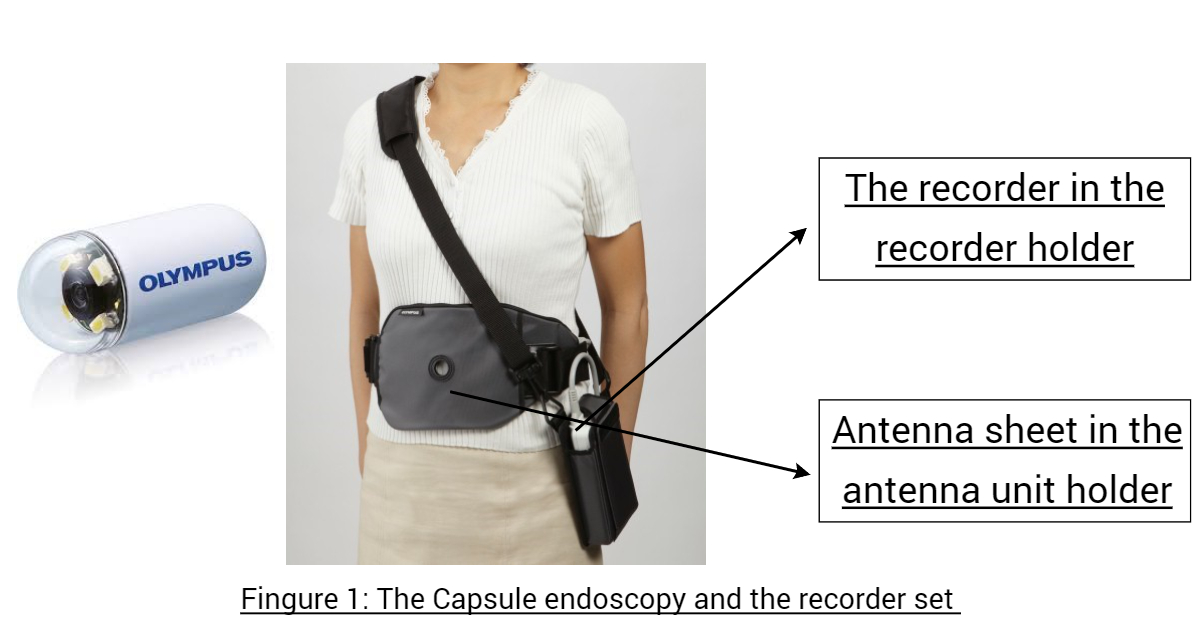CAPSULE ENDOSCOPY

Hi,
Your physician has determined that you should undergo an examination called "capsule endoscopy" as part of your medical evaluation.
You will be asked to ingest the Olympus EC-S10 for this examination. The capsule takes pictures as it moves through your digestive system. The pictures are transmitted from the capsule via the antenna sheet attached to your abdominal area to the recorder secured on your waist All the pictures are stored on the recorder.
Complication
During the examination, there is a slight possibility of unexpected retention of the capsule. In the worst case, surgical removal of the capsule may be required. If you have any concerns about capsule retention please raise these with your physician.
How often does it occur?
- Obscure GI Bleeding – 1.4%
- Established IBD – 13%
- Suspected IBD – 1%
- Suspected SBO – 1%
- Healthy SBO – 1%
Patients with one of the following conditions cannot undergo the examination
- Patients with a cardiac pacemaker, implanted cardiac defibrillator or other implanted electronic devices.
- Patients with known intestinal strictures, adhesions, diverticulitis, obstruction, or fistulas that may block the passage of the capsule endoscope.
- Patients with significant difficulty in swallowing a tablet as large as capsule endoscope.
- Patients with known swallowing disorders.
- Patients who cannot undergo surgery to remove the capsule when retention of the capsule occurs.
- Pregnant women.
- Patients with known significant delay in passing through of the capsule endoscope in the gastrointestinal tract.
- Patients diagnosed as radiation enteritis.

Preparation for Capsule Endoscopy
- Five days before your capsule endoscopy, discontinue taking Iron, Pepto Bismol and anti-acids (Mylanta, Maalox or similar). DO NOT STOP ANY OF YOUR OTHER MEDICATIONS.
- Do not schedule any X-Rays (Barium Enemas, Upper GI or Small Bowel Series) CAT scans or any diagnostic test that uses barium as a contrast agent.
- Obtain a gallon container of “PEG 3350 Ellectrolytes” with the prescription enclosed.
Day Before Capsule Endoscopy:
- No solid foods and stay close to a bathroom facility.
- You must follow a clear liquid diet (e.g. water, plain coffee, tea, gelatin, apple juice, white grape juice, chicken broth, beef broth, Gatorade.)
- You must AVOID any red or purple products
- At 3:00 pm take 2 Dulcolax, at 6:00 pm start drinking the PEG 3350 Electrolytes solution. Drink 8 ounces of solution throughout 10-15 mins. Drink 1 gallon (128 oz.) solution until you complete the entire bottle. This laxative may cause multiple bowel movements, stay within easy reach of toilette facilities.
- You may use a small amount of lemon juice or small amount of Crystal Light to flavor the solution if needed. You may suck on lemon slices as well.
- Refrigerate or chill the solution to make it easier to swallow. Sometimes drinking the solution through a straw is helpful.
- Do NOT eat or drink after midnight (minimum of 8 hours before your procedure)
- You will know you have done a good job completing your prep solution once your stools are clear and watery. The stool should not be muddy or thick.
- You may experience some bloating, cramping, nausea, diarrhea, and/or vomiting. This is usually temporary and the symptoms will gradually improve. You may feel weak, especially if you have not taken enough fluid with the prep solution and can be remedied by increasing your fluid intake.
- Wet aloe wipes and a zinc oxide based ointment may relieve any soreness related to stool evacuation.
Day of Capsule Endoscopy:
- You must abstain from eating or drinking (but if necessary, you may drink small amounts of water) 8 hours before the examination.
- If you are on medication, please consult your physician(s) to determine if added precautions need be taken during and/or after the examination.
- Avoid wearing a dress or a one-piece-suit. Wear a separate top and a bottom so that the antenna cable can be connected to the recorder that is fitted to your waist.
- During the examination, you are allowed only a thin layer of clothing to be placed between the body and the antenna unit holder.
- The antenna unit holder will be used to attach the antenna unit to your abdominal area.
- Ingest the capsule endoscope with a sip of water. Do not bite the capsule endoscope.
- Do not look directly at the capsule endoscope's LED for prolonged duration. You may feel dizzy due to the afterimage.
- The capsule endoscope contains metal parts. While the capsule endoscope is in your body, stay away from any equipment such as MRI equipment that prohibits the wearing of metallic objects in close proximity to it. Otherwise, injury within the body cavity may occur.
- Do not bring any metal such as a buckle of belt closer to the antenna during examination. Doing so may affect the operation ofthe antenna, resulting in a failure ofthe examination.
- If you experience stomach pain, discomfort, or nausea after ingesting the capsule endoscope, consult your physician immediately.
- Do not drink for 2 hours after ingesting the capsule endoscope. Do not eat for 4 hours after ingesting the capsule endoscope. You may drink small amounts of water if necessary.
- Stay away from any equipment that generates strong electromagnetic fields (such as MRI equipment, amateur (ham) radio, etc.) . Do not use radio transmitting devices such as keyless entry devices or stay in an area where other persons who may use them frequently to reduce the possibility of dropped video frames caused by the use of these devices.
- Since the capsule endoscope contains a radio transmitter, you cannot fly in an airplane until the examination is completed.
- If you will be receiving other medical treatments during the examination, consult your physician beforehand.
- Do not assume any position that may delay digestion for a long period of time.
- DO NOT OPERATE THE EQUIPMENT unless permitted by your physician. Handle the equipment with care. Refer to the following:
- Do not turn off the recorder.
- Do not remove the recorder holder and the antenna unit holder from your body.
- Do not remove the equipment from the holder.
- Do not operate any buttons on the recorder other than the button to stop the beep and vibration when a message from the recorder is displayed.
- Do not bump or drop the equipment.
- Do not run or move wildly.
- Do not pull or bend the antenna cable.
- Do not wet the equipment with water or any other liquids.
- After the procedure is completed, the examination equipment will be removed by our staff (s).
- Contact the our office immediately if the equipment operates abnormally during the examination.
- Be careful that the antenna unit holder does not move from the attached position and that the antenna unit holder is not separated from the surface of the your body. Otherwise, noise may appear in the images, or the images may not be transmitted properly.
- Adjust the position of the antenna unit holder so that the alignment hole of the antenna unit holder aligns with the umbilical position of the patient if the antenna unit holder slips off.
- The antenna unit must not be removed until the procedure is completed. If you experience any discomfort such as pain while the antenna unit holder is attached, please inform your physician.
After the Examination:
- The capsule endoscope contains metal parts. While the capsule endoscope is in your body, stay away from any equipment such as MRI equipment that prohibits the wearing of metallic objects in close proximity to it. Otherwise, injury within the body cavity may occur.
- The capsule endoscope will be excreted naturally in your feces. Please observe the capsule endoscope in your feces. Do not retrieve the capsule endoscope from your feces.
- If the capsule endoscope is not excreted within two weeks after the examination, consult your physician. When excretion of the capsule endoscope is not confirmed, you may need to undergo an X-ray examination. If the result of the X-ray examination shows retention of the capsule endoscope, it has to be retrieved by either a surgical operation or a conventional endoscopic procedure within 30 days from ingestion.
- Do not look directly at the capsule endoscope's LED for a prolonged duration. You may feel dizzy due to the afterimage.
